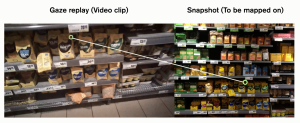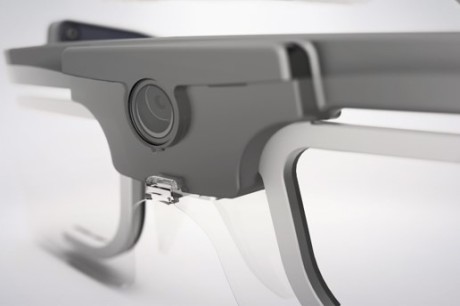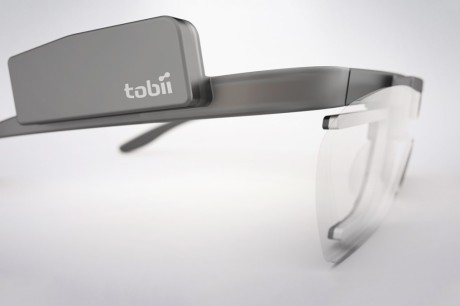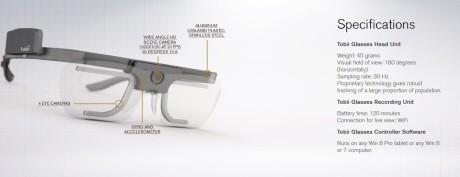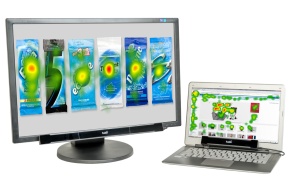Faster Than a Speeding Eye Tracker November 24, 2015
Posted by Jon Ward in eye tracking, Glasses, Technology, Tobii, Updates.add a comment
We are happy to announce that there is a new addition to the Tobii Glasses 2 eye tracking family… there are now options for both 50hz and 100hz binocular eye tracking with Tobii’s unique 4 camera tracking solution which gives automatic compensation for slippage and movement of the head unit. 100hz allows more granular use of the data, better noise filtering and also the ability to investigate velocity based algorithms with more accuracy than before while retaining ease of use, a super lightweight head unit design and live viewing wired or wireless capability!
100hz solutions are available for order now and shipping in December – existing 50hz Tobii Glasses 2 customers can also upgrade – please contact Acuity for more information or a demonstration.
Tobii Glasses 2 Real World Mapping – Saving Time in the Real World! October 29, 2015
Posted by Jon Ward in eye tracking, Glasses, Market Research, Marketing, Media, Shopper Research, Technology, Tobii, Updates, Usability & UX.Tags: eye tracking, Tobii, upgrade
add a comment
The Tobii Glasses 2 have been a huge success, with the wide angled field of view, live wireless viewing and automatic slippage compensation thanks to the unique 4 camera binocular tracking more and more people are able to do some great fieldwork both unassisted and in a more traditional context. However as with all glasses based eye tracking platforms the analysis of the data is more time-consuming than with a screen based system as you need to code the user data onto reference images to create aggregated visual outputs and statistical metrics. This can be very time-consuming and depending on the type of interactions mapped (fixation or raw data) combined with the environment and task of the user (unboxing a product, retail purchases, driving and so on) can take anywhere from 10 to 20 times the duration of the recording to code – so 100 minutes of total recorded interactions could take upwards of 16 hours to code before you can begin the analysis.
Tobii Real World Mapping can help reduce this time considerably in many types of study by using advanced computer vision to automatically detect the gaze points based on the reference images you upload – meaning that 10x or 20x multiplier comes down to as little as 2-5x, and processing can be queued so the software can happily run along in the background freeing up valuable staff resources to focus on other tasks.Once the automatic process is completed you are presented with a chart plotting the automatically mapped points, alongside a confidence level in its accuracy and then any missed points (for example if there was a large amount of occlusion in the frame) or mapped points that need some adjustment can be manually corrected by a researcher.
This video has a brief overview of this exciting feature which will be part of next update of the Tobii Glasses Analyzer software.
Of course not every single study will be able to take advantage of the new functionality, for example very dynamic content such as sports science studies have few or no fixed reference points to work with, objects that are largely occluded constantly or are at extreme distances will not be viable but for a large number of shopper studies, product interaction, mobile and tablet applications, advertising and navigation tasks users should see a significant time savings to using the tool – and by running a pilot (see tip 28 on Tim’s Acuity Intelligence blog for a reminder of the importance of this : http://www.acuity-intelligence.com/blog/eye-tracking-tips-26-30) you can quantify this benefit and also ensure that your reference images are correct and work well – more about that another time!
The Real World Mapping is ready to demonstrate to customers now – so get in touch and we will be happy to walk you through it, and show how it can help you process your glasses based eye tracking data quicker!
Tobii Glasses 2 – The next generation of mobile eye tracking May 20, 2014
Posted by Jon Ward in eye tracking, Glasses, Technology, Tobii, Updates, Usability & UX.add a comment
Today Tobii and Acuity are proud to announce the next generation worn eye tracking system. The Glasses 2 platform succeeds the hugely popular Tobii Glasses and is the culmination of years of research and development, interviewing and understanding customer needs and takes advantage of the very latest technological developments.
There are several key issues raised when we discuss glasses based eye tracking systems with our clients :
- Does the frame feel natural and does it interfere with peripheral vision?
- What is the field of view of the system, can I track everything the customer looks at?
- What is the glasses slip or they move them?
- Can I read what they are reading?
- Can I watch what they do during the testing, like I do with my screen based eye tracker?
To answer question 1 take a look at the image below, showing the new Glasses 2 frame, the arms and design are very similar to a normal pair of spectacles, the lenses are clear, with no large frame to restrict vision or blinker you into looking forward. The eye cameras are mounted very discreetly in the arms reaching down from the bridge, so not only are they a clear and crisp design, they don’t obscure your field of view, don’t blinker your peripheral vision (essential in driving / sports / shopper studies) but the user will also be less conscious about wearing the frame in public, meaning more naturalistic behaviour.
So we move onto the field of view of both the scene camera and the eyetracking data. Until now mobile eye tracking platforms have used 1 or 2 cameras (either monocular or binocular) to track the users eyes, Tobii have gone with 4 cameras, two per eye and the benefits are immediately obvious. By having two cameras per eye you instantly have a much wider degree of movement on each eye that can be tracked, not only that but by using Tobii’s patented 3D eye modelling the system can also compensate for slippage of the frame – something that has been a curse of eye tracking studies when shoppers move the frame, sports people move quickly or when testing with children who interfere with the frame. Of course being able to track a wide range of movement is not good unless we can visualise the data on the scene camera video, and here we see a huge 675% increase in the number of pixels over the Glasses 1 platform, meaning that the camera is running at a HD resolution of 1920×1080 pixels. To ensure that the field of view that is tracked maximises the rest of the platform, the camera field of view has been vastly improved to give 90 degrees diagonal FOV, around 25-30% larger our competitors products, the un-obscured frame also means that users have a visual field of view of 160 degrees – so testing is more natural, across a wider field of view in every dimension!
With this increased field of view, high definition camera and dual camera binocular tracking mobile testing, packaging, reading studies and more all spring to life with the moderator being able to see every interaction, and this can also now be done live via either a cable or wireless connection to a Windows PC or tablet – opening up endless possibilities for testing, and the ultimate in flexibility. With the basic system allowing for post testing recording via the recording device the entry price point is incredibly attractive, and users can upgrade the system as their needs evolve.
So the 5 key questions we get asked are all ticked off and Tobii haven’t stopped there, there is a new gaze mapping platform allowing for aggregated data across multiple participants, visual and statistical outputs and A/B comparison testing. There is also of course a microphone to record user audio, the scene camera has been angled to ensure that close interactions are captured, a gyroscope and accelerometer embedded for future development and interactions and of course world class eyetracking accuracy and precision!
We are expecting to ship units in October so please contact us to arrange a demo or for more details or visit http://www.tobiiglasses.com.
The New Tobii X2 Eye Tracker – The Smallest And Most Flexible Eye Tracker On The Market! February 11, 2013
Posted by Natasha French in Advertising, eye tracking, Market Research, Marketing, Media, Shopper Research, Technology, Tobii, Uncategorized, Updates, Usability & UX.add a comment
Acuity are proud to present the new Tobii X2 eye tracker – a ground breaking development in delivering the smallest and most flexible eye tracker on the market!
The Tobii X2-30 Eye Tracker (available in Compact Edition and Wide Edition) is a revolutionary small eye tracking system, powered by the latest generation in innovative eye technology from Tobii.
The Tobii X2 family comprises of eye tracking systems at 30 and 60 Hz. The X2 can easily be clipped on to a laptop, a PC monitor, or even a tablet for a compact and is our most portable system yet!
Research anywhere – Small footprint accommodates truly portable solutions and enables expansion of eye tracking from lab to real-life environments.
Supreme efficiency – Ease of set up and operation paired with very robust participant tracking allow for cost efficient studies.
Trust your data – Unparalleled tracking accuracy within a revolutionary large head movement box ensures reliable and valid research results.
Choose between the Compact Edition and the Wide Edition – depending on your specific study context!
The Compact Edition is a smaller version of the eye tracker, measuring 184 mm (7.3’’) in length. You can use it as your portable lab or for studies that require a small eye tracker to track what participants see on:
- Laptops and smaller PC monitors up to app. 22’’
- Tablets and mobile phones (dedicated mobile device accessories will be available soon)
- Small real-world interfaces
The Wide Edition is designed for studies that require larger gaze angles (up to 37°) and enables studies that involve larger stimuli, being able to track interfaces such as:
- PC monitors up to app. 27’’
- TV
- Projections and simulators
- Large real-world interfaces
Acuity are offering both rental and purchase options. As always for more information please contact the Acuity team at; sales@acuity-ets.com or (0)1189000795!
Why 2013 Is Going To Be Even Better For Our Clients…. February 5, 2013
Posted by Natasha French in eye tracking, Market Research, Shopper Research, Technology, Tobii, Uncategorized, Updates, Usability & UX.add a comment
It’s been a busy couple of years with exciting developments here at Acuity. Key to this was the launch of Acuity Intelligence just over a year ago and the addition of Technical Director Dr Tim Holmes. I’ve had a few clients contact me, curious to find out the difference between the two companies: Acuity ETS and Acuity Intelligence (ETS and AI for short!). Reflecting on 2012 and what it held for the group, I thought the New Year might be a good time to clarify the difference between both and explain why 2013 is going to be even better for our clients.
Acuity ETS
Most of you reading this will already be aware of Acuity ETS. You’ll know our Directors and hopefully come to us when you have an eye tracking sale / rental requirement. Alongside this, ETS also offer training and support, giving you the tools and ‘know how’ to complete your own independent research effectively and use scientific technology to answer difficult commercial questions.
Now, if any of you know our Directors well, you’ll also be very aware that they are technology geeks (this enthusiasm is a must for anyone that joins the Acuity team!). With a (slightly obsessive) thirst for new tech, it wasn’t long before other tools that could supplement gaze data were also found by the guys. Wanting to offer these to clients too – the idea of Acuity Intelligence began!
Acuity Intelligence
Customer tracking / counting technology, facial and emotional recognition solutions, non-intrusive biometric sensors, browser based eye tracking to name but a few, the supplementary offering expanded quickly along with the AI team.
The end of 2011 welcomed a new company Director and Vision Scientist, Dr Tim Holmes. Actively involved in scientific research as a university lecturer, Tim was the catalyst for AI offering additional research and consultancy services based on real science. Services which include education about why technologies such as eye tracking and galvanic skin response are important measures of consumer attention and emotional engagement; the design of rigorous and innovative research projects that maximise the value of client investment by using the right combination of methodology and technologies to answer client questions; and innovative analysis and presentation of results that are scientifically accurate, replicable and focus on the meaning of the data, rather than just the numbers themselves. With Matlab and E-Prime consultancy offerings, AI also supports experiment development and data analysis in a number of Universities in the UK and beyond and is actively involved in cutting edge research at a number of institutions. In addition to all this, AI now also has product integrators and software developers in house who are feverishly beavering away on some truly unique off-the-shelf solutions as well as bespoke solutions tailored to the needs of specific customers!
Working together for you in 2013
Both sister companies offer something very different but both work together seamlessly on your behalf to provide you with a more complete research solution for 2013; all equipment rental, technical support and analysis or simply the technology and knowledge that will enable you to complete your own independent research well. We hope that by extending our offering to you, we can offer a more flexible way to make use of new technologies that add real scientific value to your research.
Tobii Studio 3.2 Launched December 18, 2012
Posted by Jon Ward in eye tracking, Studio, Technology, Tips And Tricks, Tobii.add a comment
We are pleased to announce the latest version of the worlds most popular eye tracking analysis software. Studio 3.2 has a number of new features including task based segmentation, a new visualisation tool and a number of performance tweaks. Go to the Tobii website and download it now, if your support and upgrade contract isn’t up to date then get in touch with us and we will give you a quote so you can continue to enjoy the constant improvements and new functionality of Tobii Studio.
Physiological Tools For Market Research, Usability, HCI, H&S and More! March 19, 2012
Posted by Jon Ward in eye tracking, Glasses, Market Research, Shopper Research, Technology, Tobii, Usability & UX.add a comment
Acuity are proud to announce their latest partnership with French company, TEA. By adding their products to our portfolio we can now offer a range of sensors to monitor GSR, sEMG, heart rate, acceleration, orientation and gornio / torsio movements – and more! Utilising a simple but powerful interface the Captiv range of software allows multiple data sources (video, EEG, eye tracking, physiological sensors, etc) to be synchronised and analysed using powerful a coding mechanism giving you instant access to the data.

The Captiv L2100 software allows post event coding of a video stream and is ideal for sports science, ergonomics, health & safety, zoological studies and more – allowing the user to quickly isolate events, transitions and elements of interest. It can also be used to analyse data captured with the L7000 software which opens up great opportunities for commercial and academic institutes to capture and share data and equipment accordingly.
The L7000 software allows observation and analysis across a wide range of platforms and data sources – including live integration with Tobii and FaceLab eye tracking units. Post synchronisation of almost any other eye tracking platform is also possible meaning this is a great addition to any research facility. As well as offering the powerful coding tools of the L2100 software, you can also add the T-Sense range of sensors to your projects, meaning GSR, heart rate, FSR, sEMG and more can be captured and synchronised to your other data streams – including up to 10 video sources! This gives you the power and flexibility to observe a user from various angles, monitor multiple users in an environment, study team dynamics or measure a user physiological state during computer gaming… and more! With the capabilities to record locally to a PC or to the T-Log recording device (which is around the size of a 1st generation iPod) the system is quick to deploy and incredibly portable.

As you can see from the image – the sensors are incredibly small and lightweight, so the user is barely aware of them during testing. The system is fully customisable and additional sensors can be bought ad hoc to suit specific requirements. We have recently used these sensors for projects with the National Geographic channel, BBC Radio 4 and Oxford University and have been massively impressed with the flexibility, data and capabilities of the system.
Please contact us for more details or to discuss specific requirements, or to arrange a demonstration – sales@acuity-ets.com
Tobii Studio 3.0.2 Available to Download February 20, 2012
Posted by Jon Ward in eye tracking, Studio, Tobii, Updates.add a comment
For all our customers with current support and upgrade contracts please go to http://studiohelp.tobii.org/Updates/ with your licence key handy – this minor release tweaks some of the functionality released in Studio 3.0. For those without a support contract please get in touch with us at sales@acuity-ets.com to discuss your options.
X1 Light Introduction Webinar On YouTube February 20, 2012
Posted by Jon Ward in eye tracking, Glasses, Media, Technology, Tobii, Updates.add a comment
The recently launched X1 Light has proven a big success – opening up that possibilities of eye tracking where you want, when you want! Now Tobii have posted their recent webinar that introduces the X1 Light and it’s capabilities. See Tommy Strandvall go through its functionality here : http://www.youtube.com/watch?v=1IRzaDpBbGw
Tobii Launch the X1 Light Eye Tracker – Take Your Testing On The Road…. EASILY! January 27, 2012
Posted by Jon Ward in Advertising, eye tracking, Market Research, Marketing, Media, Studio, Technology, Tobii, Updates, Usability & UX.add a comment
Earlier this week Tobii launched another groundbreaking product – the X1 Light.
The X1 Light eye tracker is a truly portable lab, that you can literally fit into your laptop bag and test in situ, wherever and whenever you want. With device stands for both desktop, screen based, laptop based and real world testing this is a hugely flexible piece of equipment for market research, usability and more. There is plenty of information on our website about the X1 Light here : http://www.acuity-ets.com/products_x1-series.htm and you can also see an introduction video here : http://www.youtube.com/watch?v=_B1r3xuqDck
The X1 Light can be used with the free of charge Morae plug-in for usability studies or you can use it with Tobii Studio, the most popular eye tracking analysis software in the world!
For more information, specifications and pricing please don’t hesitate to contact sales@acuity-ets.com .

